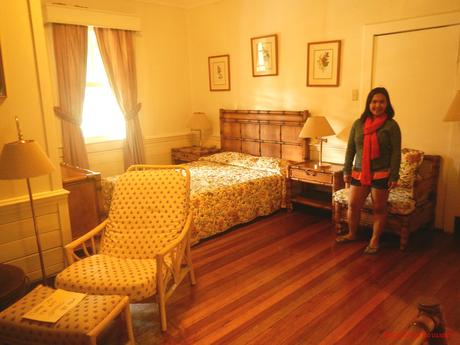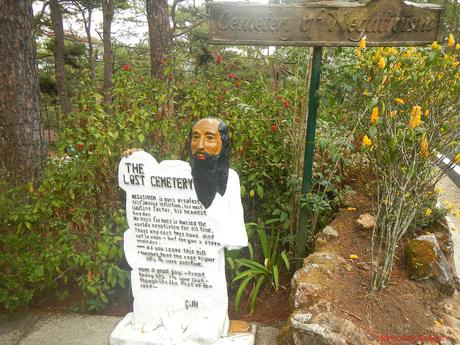
We have a loveable country. A lot of visitors from other nations can't resist our motherland's call and come back here when given the opportunity. fact, many foreigners have deeply fallen in love with the Philippines that they plan to set up shop or residence here. Even the Americans, our conquerors in the past and our allies today, decided to set up beautiful venues for rest-and-recreation in our land.
One such R&R station is John Hay Air Station, commonly called Camp John Hay. It was established in October 1903 under the executive order of President Theodore Roosevelt. The place is named under his Secretary of State John Milton Hay. Over the course of its history, it has been bombed by the Japanese during World War 2, recaptured by the Americans, and later converted into a tourist spot.
Camp John Hay is a Special Economic Zone-a Tourism Economic Zone to be more specific). Visitors must subject themselves to a search by the zone's guards. Check out that nice-looking, shingle-roofed guardhouse. It is one of the prettiest guardhouses we've ever seen.

Easy-to-read directional signs make it convenient for visitors to go around the economic zone.

After a short ride, the taxi driver dropped as off at Liberty Loop right at the side of Camp John Hay's historical center. The Loop serves as a runabout for all vehicles visiting the camp.
Watch your step while walking on the Liberty Loop. Those exposed roots can truly snag your feet.

The heart of Camp John Hay is the Historical Core, which tells a lot about the origins of the camp. There are lots of things to experience here. We paid the standard entrance fee of P60 to get into the core.

A poster displays the attractions in the Historical Core. Let's check them out.

Panagbenga Flower Festival Marker
Do sunflowers really grow up to 12 feet? No, not really. This gigantic, hand-crafted sunflower serves as a marker for Baguio's Panagbenga Flower Festival. The month-long flower festival is the largest of its kind in the entire Cordillera region.
Not only is the festival a tribute to the history and culture of Baguio, but it also serves as a celebration of its citizens' resilience and rise after the devastation of the tragic Baguio Earthquake in 1990.

The Totem Pole
A few steps away from the sunflower marker is this tall totem pole that features carefully carved faces. Carved by Filipino artist Ernesto Dul-ang, this totem pole pays homage to the leaders who helped develop Camp John Hay and Baguio City.

Bell Amphitheater
It has been called the Bell that Does Not Ring. But if you go down to the central gazebo of this verdant, carefully manicured amphitheater, you wouldn't find any bell at all!
Well, it turns out that the Bell Amphitheater is named after Major General Franklin Bell, the commander of the Philippine Division in 1911 to 1914. He personally designed the amphitheater, taking inspiration from the Ifugao's terracing technique.
Today, the Bell Amphitheater is a popular venue for weddings, photo shoots, and special events. Obviously, it is also a place for quiet afternoon walks.

Bell House
Above the amphitheater is this beautiful colonial residential structure. This was once the warm and comfortable residence of American commanders who visited Baguio. Along with the amphitheater, it was General Bell who designed the house, which is now declared as a historic landmark.

One side of the house-perhaps, this was a foyer or a private study in the past-was converted into a library and museum. We weren't able to go in as it was closed when we got there.

The front of the house features a beautiful flower-laden garden. The full blossoms give the front yard vibrant splashes of color.
At night, these Japanese lanterns light up not only to provide illumination but also to unify the night landscape.

Lovely flowers, aren't they? There are plenty of flowers like these around Camp John Hay.

The long terrace is reminiscent of old American houses during the Civil War. Check out those warm wooden boards and the gleaming, thoroughly polished hardwood floor.

Let's go inside and explore the interior of the house. We were quite interested in this warm, wood-streaked dining room. The combination of warm light, gleaming wood, multi-patterned wallpaper, and classic furniture and accessories must have provided guests a nice dining experience.
We can almost imagine impeccably dressed, mustached men discussing military strategies while drinking wine or smoking fat cigars.

That polished floor looks really lovely, isn't it? We wish our floor back at home would be as shiny as this.
This main hallway leads to other areas of the house, which seems bigger inside than its looks outside. We actually took a wrong turn and ended up in a fully operational modern kitchen where we were prohibited from entering.

With two beds and multiple couches, this must be the guest bedroom. With Baguio's cool temperature, it must be heaven sleeping in these warm, clean sheets.

The commander's bedroom is slightly larger than the guest bedroom and has a single bed. Don't you just want to lie down or sit on any of those cushy couches?
A lot of the furniture in this house are made of native materials such as bamboo and rattan.

The house's wooden loggia extends all the way to the back. Thus, wherever you go, you get a great view of the amphitheater, gardens, forests, and hills that surround the Bell House.

History Trail and Secret Garden
Learning about history while hiking? Why not? That is offered at the History Trail, which starts right across the Bell House. It's a nice place to hike, considering the cool air and the picturesque scenes.
Although you can ask a park ranger to accompany you, the trail is very well established, and you can self-guide your way through it.

These nice picnic tables are placed right at the jump-off of the trail. You can take your snacks or simply relax here before you undertake the trek.

Learn the history of Camp John Hay as you walk the trail. Carved reliefs and display boards scattered along the History trail eloquently tells the story of the camp and the surrounding areas.

Don't worry if you forgot to wear your trekking sandals or shoes. The 500-meter trail has cemented pathways, so you can walk on it with your slippers or casual shoes.
Along the way, we saw these labelled trees. This suggests that the forest, or a few of the trees in this area, is second-generation and not the original pine trees that once dotted this place.

This sky bridge in the middle of the park looks pretty awesome! Too bad no one was there to man it; we would have loved to have a walk on treetops.

In the middle of the trail is the Secret Garden. We are not sure what is so secret about it since the trail actually passes through it! It's a great place for those who want solace, silence, and peace.

The Secret Garden is a small but well-taken cared off place. Different indigenous flowers and shrubs are planted here. You can also easily here the calls of crows as they are plentiful.

On our way back to the jump-off, we passed by this nice vine-covered trellis. Also, according to the architectural model of the park displayed at the Bell House, there was supposed to be an old World War 2-era bunker here.
As a scale modeler who loves to make World War 2 dioramas, I was adamant that we check out the structure. Unfortunately, Sweetie and I weren't able to spot the bunker.

Cemetery of Negativism
Another popular yet unusual attraction in the Historical Core is the Cemetery of Negativism, otherwise known as the Lost Cemetery. Like many places in Camp John Hay, it is nestled in a beautiful pine-laden forest. But unlike other traditional cemeteries, the dead aren't buried here.

So what is buried in the Cemetery? Well, this is the burial place of all negative thoughts that has plagued mankind. This is the resting place of the negativism that has become mankind's self-imposed restriction.

This is one of my favorite gravestones. The idea of impossibility is buried here! Anything is possible if you make up your mind!

The Cemetery of Negativism features a well-establish trail in front of the Bell House adjacent to the History Trail. The Cemetery is designed by then-base commander Major John Hightower.

Outside the Historical Core
The hike around the History Trail and the Cemetery of Negativity was too short for us. So we decided to hike all the way to the entrance gate. Along the way, we passed by this nice playground and sports courts.
It was empty when we got there, but we can feel the ghosts of excitement from laughing children and competing players.

A little farther down the road, we stopped by the Mile Hi Center, Camp John Hay's commercial component. The strip mall has retail shops, boutiques, restuarants, and other commercial establishments for the convenience of Camp John Hay's residents and visitors.

Okay, we're not really a great fan of vehicles. In fact, we could have bought one now to be used in our travels. But with the cost of upkeep, depreciation, and a tendency to lose our tempers when stuck in heavy traffic, having our own sedan, town car, or SUV is not something that we look forward to as of now.
But this muscle car just made us salivate. Just check out that sexy, powerful machine!

We also passed by The Manor, one of Baguio's most prestigious hotel. In fact, it could definitely satisfy the ultra-discriminating taste of James Bond when it comes to luxury.

That's Camp John Hay's clubhouse, which features a very contemporary architecture. It stands as a stark contrast against the rustic environment and the classic design of the other buildings in the area.

It was an hour-long hike back to the gate, but that was okay. The rapidly dropping temperature made the hike very comfortable. Along the way, we found residents and visitors taking advantage of the cool late afternoon by hiking, running, and biking.

This was also the first time we've ever seen a golf course up close. Just check out that velvety, carefully trimmed grass in the green. It looks so soft that we just want to lie down on it!

Outside the gate, we waited for 10 minutes before we were able to hail a taxicab to take us back to the city where we had dinner at Cafe Cueva.
Indeed, visiting Camp John Hay took us to a glimpse of American culture and history during their occupation in the Philippines. It is not difficult to understand why Americans chose this particular hill for their R&R venue; Camp John is definitely a place where one can rest his or her body and mind.

